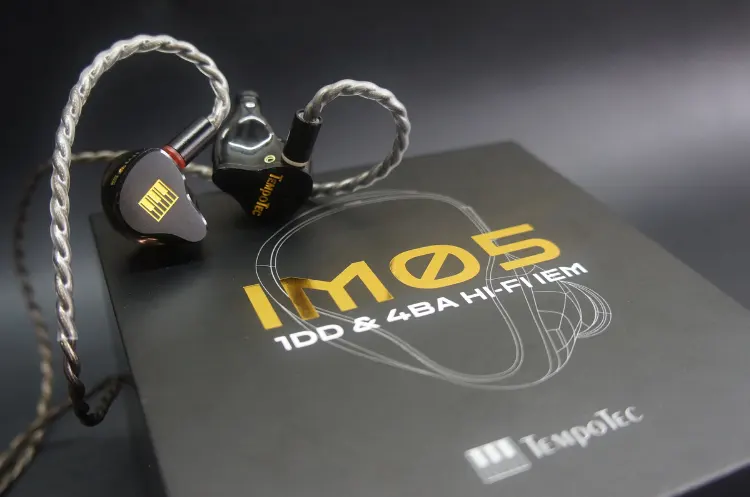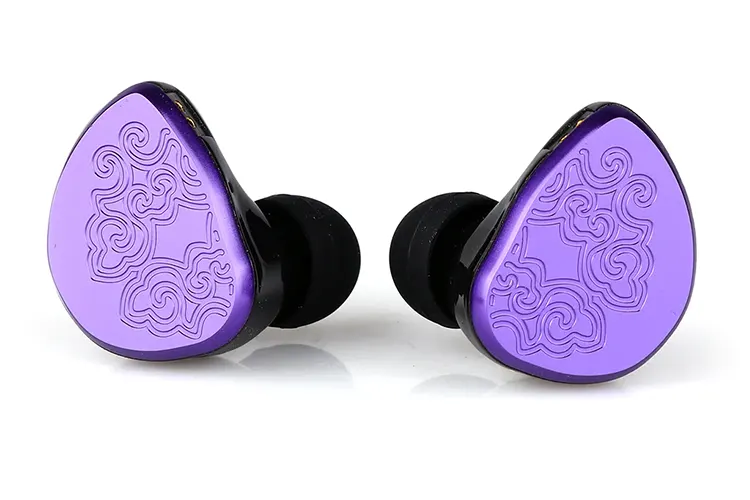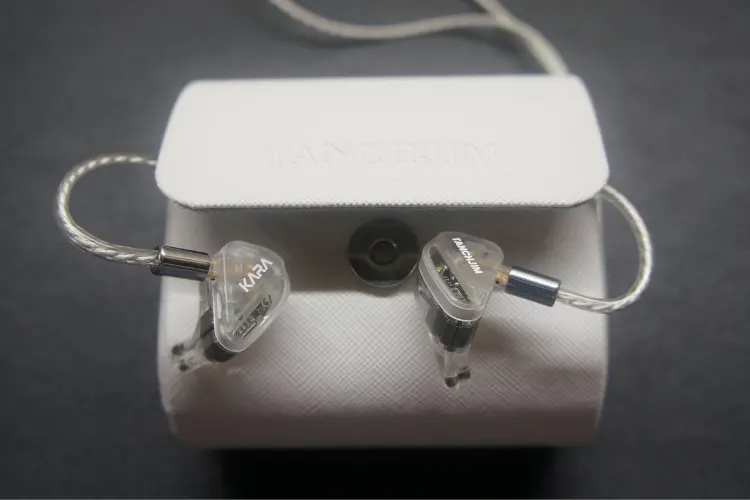Synergy
Efficiency
The Kara is not as efficient as you’d expect and needs at least a dongle DAC to live up to its full potential. Despite its low impedance of 27Ω and a high sensitivity rating of 115 dB @1kHz, it needs some power to reach loud volumes.
Dongle DACs would suffice, but they benefit from a good source such as the iFi Audio ZEN DAC that can provide enough power and control to its dynamic driver. It also scales well with higher-quality sources that can bring out more detail and refinement in its sound.
Pairings
The Kara pairs well with sources that have a neutral or slightly bright sound signature, as they can balance out its warm mid-centric tuning and bring out more treble presence and detail.
In my experience, the warmer-sounding 7HZ SEVENHERTZ 71 Dongle DAC did a good job in a pinch, however, I found that the Kara performed the best with my desktop iFi Audio ZEN DAC.
Select Comparisons
Tempotec IM05
Technical
Both the IM05 and Kara make use of a single dynamic driver and a 4 BA configuration The TempoTec IM05 uses an 8mm dynamic driver and four balanced armature drivers with an impedance of 33Ω and a sensitivity of 99dB @1kHz.
The Kara makes use of a single 9mm dynamic driver, a pair of Sonion 2389 BA drivers, and a pair of custom Tanchjim BA drivers for frequencies beyond the 10kHz range.
The Kara has an impedance of 27Ω and a sensitivity of 115dB, making the IM05 easier to drive. Additionally, the IM05 makes use of the standard 0.78mm two-pin connector, whilst the Kara makes use of the shrouded QDC style 0.78mm two-pin connector.
Design
The IM05 makes use of a shell that seems to be constructed from 3D-printed resin with a dark glossy finish, whilst Kara’s shell is also constructed from a resin DLP3D Printed shell with a transparent finish similar to the Moondrop Blessing 3.
Both the Kara and the IM05 make use of a resin shell and a separate face plate, with the one on the IM05 having a brushed black metal finish with a stylized yellow piano or TempoTec logo, and the one on the Kara being constructed from translucent plastic.
The Kara fits better in the ear due to its smaller size and lighter build, making it significantly more comfortable all around and perfect for all-day listening. However, this does not mean that the IM05 is uncomfortable by any means, the DZ4 is simply superior in terms of comfort.
The superior cable of the Kara also contributes to improved comfort since it is lighter and less prone to being tangled in my shirt or pockets.
Performance
The IM05 makes use of a V-shaped tuning philosophy that leans more toward the warm end, whilst the Kara makes use of a warm leaning mids-focused sound signature.
The IM05’s V-shaped sound signature makes it have more bass quantity than the Kara, especially in the mid-bass region, where it has more punch and slam.
However, the Kara has better bass quality than the IM05, as it has more sub-bass extension, texture, and decay. The Kara’s bass is more solid and impactful, while the IM05’s bass is more boomy and bloated.
The midrange of the Kara is more forward and natural than the IM05’s midrange, which is more recessed and thinner. The Kara’s midrange is richer, smoother, and more realistic, while the IM05’s midrange is leaner, brighter, and more artificial.
The Kara’s midrange has better timbre accuracy, tonal balance, and resolution, especially when it comes to string instruments like guitars.
The treble of the IM05 is more present and energetic than Kara’s treble, which is more relaxed and smoother. The IM05’s treble has more sparkle, air, and extension, but also more sibilance, harshness, and fatigue.
The Kara’s treble has less detail, clarity, and liveliness, but also less peakiness, brightness, and aggressiveness. The treble of the IM05 is more analytical and technical, while the treble of the Kara is more musical and easygoing.
The imaging of both IEMs is similar, with good accuracy and precision in sound placement. The soundstage of the Kara is more intimate and narrower than that of the IM05.
The separation and layering of both IEMs are good, but not exceptional. Both IEMs have a coherent and musical sound but with different sound signatures.
Tangzu Zetian Wu
Technical
The Zetian Wu uses a single driver setup with a 14.5mm planar magnetic driver on each side. They have an impedance of 16Ω, and a sensitivity of 100dB/mW, meanwhile, the Kara makes use of a single 9mm dynamic driver, a pair of Sonion 2389 BA drivers, and a pair of custom Tanchjim BA drivers for frequencies beyond the 10kHz range.
The Kara has an impedance of 27 Ohms and a sensitivity of 115dB, making the Zetian Qu easier to drive. Additionally, the Wu Zetian makes use of the standard 0.78mm two-pin connector, whilst the Kara makes use of the shrouded QDC style 0.78mm two-pin connector.
Design
Both the Kara and the Tangzu make use of a 3D-printed DLP shell, with the main design difference being their faceplate.
The Tangzu makes use of a CNC-machined aluminum face plate with a traditional Chinese pattern and an anodized purple finish, inspired by the empress Wu ZeTian during the Tang Dynasty, whilst the Kara comes with a translucent plastic faceplate.
The Tangzu has a larger shell, giving it a worse fit in the ear. The Tangzu is slightly more uncomfortable since it tends to fall off a bit more than the Kara. The Kara fits better in the ear due to its smaller size and lighter build, making it significantly more comfortable all around and perfect for all-day listening.
Performance
The Zetian Wu is a pair of IEMs with a neutral sound signature with slight elevations towards both ends of the frequency response, whilst the Kara makes use of a warm-leaning mid-focused sound signature.
The ZeTian Wu has less bass quantity than the Kara, especially in the sub-bass region, where it has less rumble and impact.
However, the ZeTian Wu has better bass quality than the Kara, as it has more speed, tightness, and control. Zetian Wu’s bass is more balanced and refined, while Kara’s bass is more boosted and organic.
The midrange of the Tangzu is worse than that of the Kara in both quantity and quality. Vocals and string instruments are much more forward and clearer with the Kara, making those on the Zetian Wu sound slightly muffled.
More importantly, the vocals on the Zetian Wu have a strange metallic timbre that makes them sound more artificial than the Kara.
The treble on the Zetian Wu is airer and has more sparkle than that of the Kara. High-pitched piano keys and cymbals crash have better resolution and decay on the Kara.
The treble on the Kara is much more relaxed and easy-going, unlike the energetic and engaging treble of the ZeTian Wu. This makes the ZeTian Wu sound more “fun” but also contributes to making it sound more fatiguing throughout prolonged listening sessions.
The Zetian Wu has a significantly wider and airier sound stage, however, its imaging performance is woefully sub-par. Different tracks in complex mixes all get mixed with one another and are difficult to isolate, whilst the Kara is the complete opposite. It has a more intimate sound stage, but its pinpoint accuracy makes individual instruments easily identifiable.
Our Verdict
The Tanchjim Kara is a hybrid IEM that offers a smooth and musical sound with warm mid-centric tuning. It has a strong sub-bass presence, a lush midrange, and a relaxed treble. It is not a perfectly neutral IEM, but rather one that emphasizes vocal emotion and enjoyment over accuracy and detail.
It is also important to highlight its very good playback of string instruments like bass and electric guitars. It does so with texture and resolution that I rarely see even in other pricier IEMS.
It suits listeners who like a warm, smooth, and natural sound with good bass impact and vocal emotion. It is not suitable for listeners who prefer a more balanced, detailed, or analytical sound with more treble presence and extension.
The Kara doesn’t try to please everyone, choosing to focus on a specific tonality, and executing it very well. If your personal tastes happen to fall within the capabilities of the Kara, I have no problem recommending the Kara.
Tanchjim Kara Technical Specifications
- Driver Type: 1DD + 4BA
- Plug: 3.5mm single-ended to QDC Style 0.78mm-2pin
- Frequency Response: 7Hz – 40kHz
- Impedance: 27Ω
- Sensitivity: 115dB





